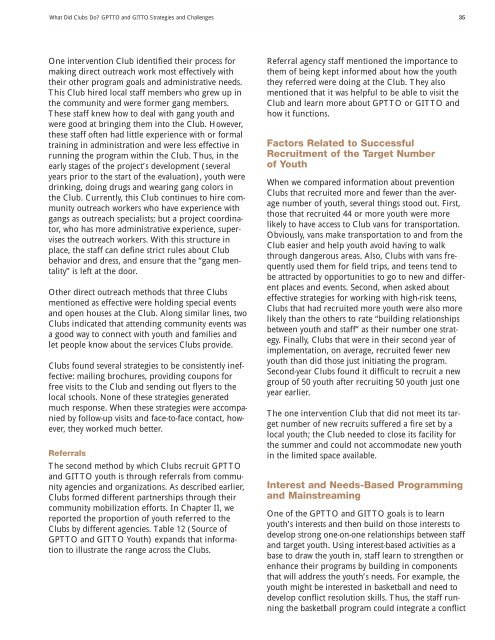Targeted Outreach - Governor's Office of Crime Control & Prevention ...
Targeted Outreach - Governor's Office of Crime Control & Prevention ...
Targeted Outreach - Governor's Office of Crime Control & Prevention ...
You also want an ePaper? Increase the reach of your titles
YUMPU automatically turns print PDFs into web optimized ePapers that Google loves.
What Did Clubs Do? GPTTO and GITTO Strategies and Challenges 35<br />
One intervention Club identified their process for<br />
making direct outreach work most effectively with<br />
their other program goals and administrative needs.<br />
This Club hired local staff members who grew up in<br />
the community and were former gang members.<br />
These staff knew how to deal with gang youth and<br />
were good at bringing them into the Club. However,<br />
these staff <strong>of</strong>ten had little experience with or formal<br />
training in administration and were less effective in<br />
running the program within the Club. Thus, in the<br />
early stages <strong>of</strong> the project’s development (several<br />
years prior to the start <strong>of</strong> the evaluation), youth were<br />
drinking, doing drugs and wearing gang colors in<br />
the Club. Currently, this Club continues to hire community<br />
outreach workers who have experience with<br />
gangs as outreach specialists; but a project coordinator,<br />
who has more administrative experience, supervises<br />
the outreach workers. With this structure in<br />
place, the staff can define strict rules about Club<br />
behavior and dress, and ensure that the “gang mentality”<br />
is left at the door.<br />
Other direct outreach methods that three Clubs<br />
mentioned as effective were holding special events<br />
and open houses at the Club. Along similar lines, two<br />
Clubs indicated that attending community events was<br />
a good way to connect with youth and families and<br />
let people know about the services Clubs provide.<br />
Clubs found several strategies to be consistently ineffective:<br />
mailing brochures, providing coupons for<br />
free visits to the Club and sending out flyers to the<br />
local schools. None <strong>of</strong> these strategies generated<br />
much response. When these strategies were accompanied<br />
by follow-up visits and face-to-face contact, however,<br />
they worked much better.<br />
Referrals<br />
The second method by which Clubs recruit GPTTO<br />
and GITTO youth is through referrals from community<br />
agencies and organizations. As described earlier,<br />
Clubs formed different partnerships through their<br />
community mobilization efforts. In Chapter II, we<br />
reported the proportion <strong>of</strong> youth referred to the<br />
Clubs by different agencies. Table 12 (Source <strong>of</strong><br />
GPTTO and GITTO Youth) expands that information<br />
to illustrate the range across the Clubs.<br />
Referral agency staff mentioned the importance to<br />
them <strong>of</strong> being kept informed about how the youth<br />
they referred were doing at the Club. They also<br />
mentioned that it was helpful to be able to visit the<br />
Club and learn more about GPTTO or GITTO and<br />
how it functions.<br />
Factors Related to Successful<br />
Recruitment <strong>of</strong> the Target Number<br />
<strong>of</strong> Youth<br />
When we compared information about prevention<br />
Clubs that recruited more and fewer than the average<br />
number <strong>of</strong> youth, several things stood out. First,<br />
those that recruited 44 or more youth were more<br />
likely to have access to Club vans for transportation.<br />
Obviously, vans make transportation to and from the<br />
Club easier and help youth avoid having to walk<br />
through dangerous areas. Also, Clubs with vans frequently<br />
used them for field trips, and teens tend to<br />
be attracted by opportunities to go to new and different<br />
places and events. Second, when asked about<br />
effective strategies for working with high-risk teens,<br />
Clubs that had recruited more youth were also more<br />
likely than the others to rate “building relationships<br />
between youth and staff” as their number one strategy.<br />
Finally, Clubs that were in their second year <strong>of</strong><br />
implementation, on average, recruited fewer new<br />
youth than did those just initiating the program.<br />
Second-year Clubs found it difficult to recruit a new<br />
group <strong>of</strong> 50 youth after recruiting 50 youth just one<br />
year earlier.<br />
The one intervention Club that did not meet its target<br />
number <strong>of</strong> new recruits suffered a fire set by a<br />
local youth; the Club needed to close its facility for<br />
the summer and could not accommodate new youth<br />
in the limited space available.<br />
Interest and Needs-Based Programming<br />
and Mainstreaming<br />
One <strong>of</strong> the GPTTO and GITTO goals is to learn<br />
youth’s interests and then build on those interests to<br />
develop strong one-on-one relationships between staff<br />
and target youth. Using interest-based activities as a<br />
base to draw the youth in, staff learn to strengthen or<br />
enhance their programs by building in components<br />
that will address the youth’s needs. For example, the<br />
youth might be interested in basketball and need to<br />
develop conflict resolution skills. Thus, the staff running<br />
the basketball program could integrate a conflict

















